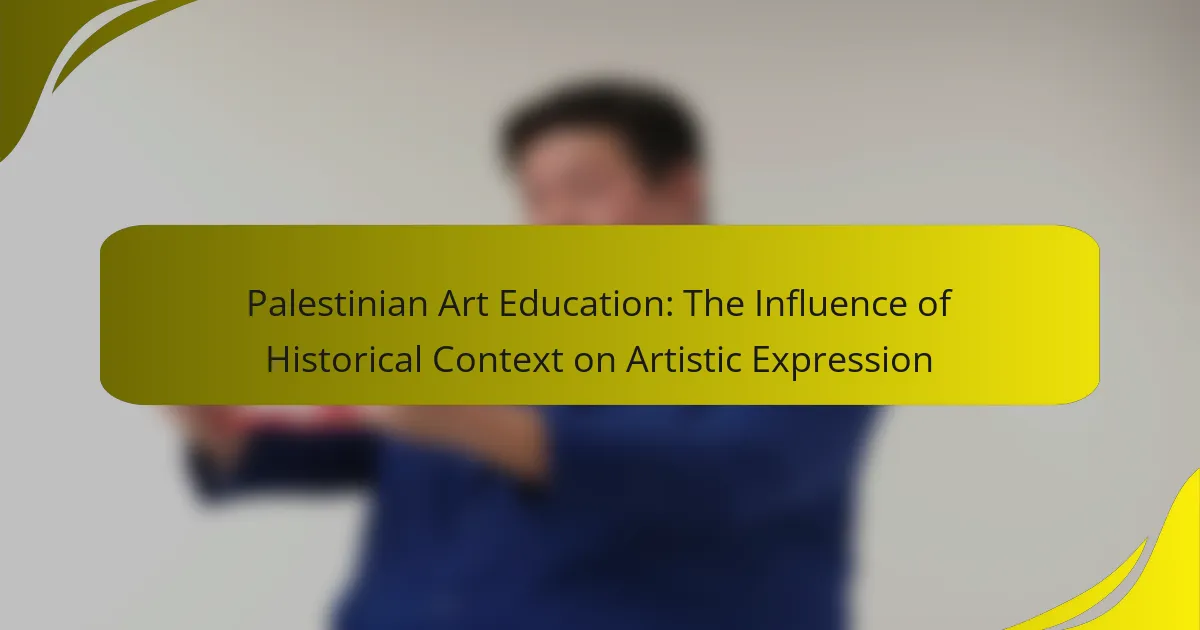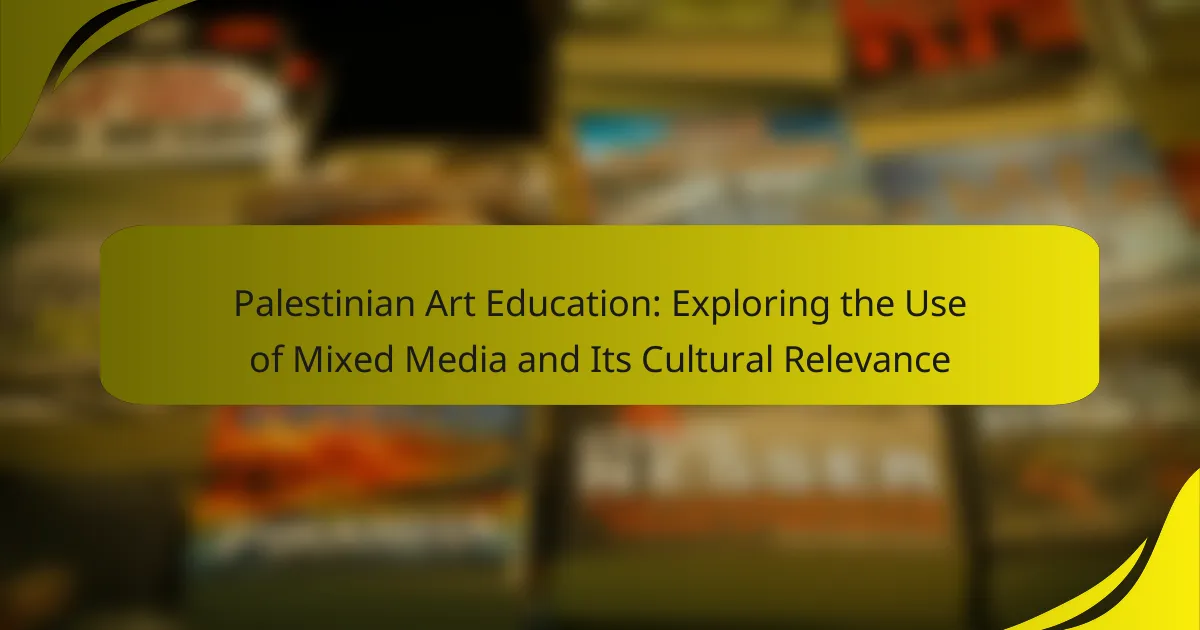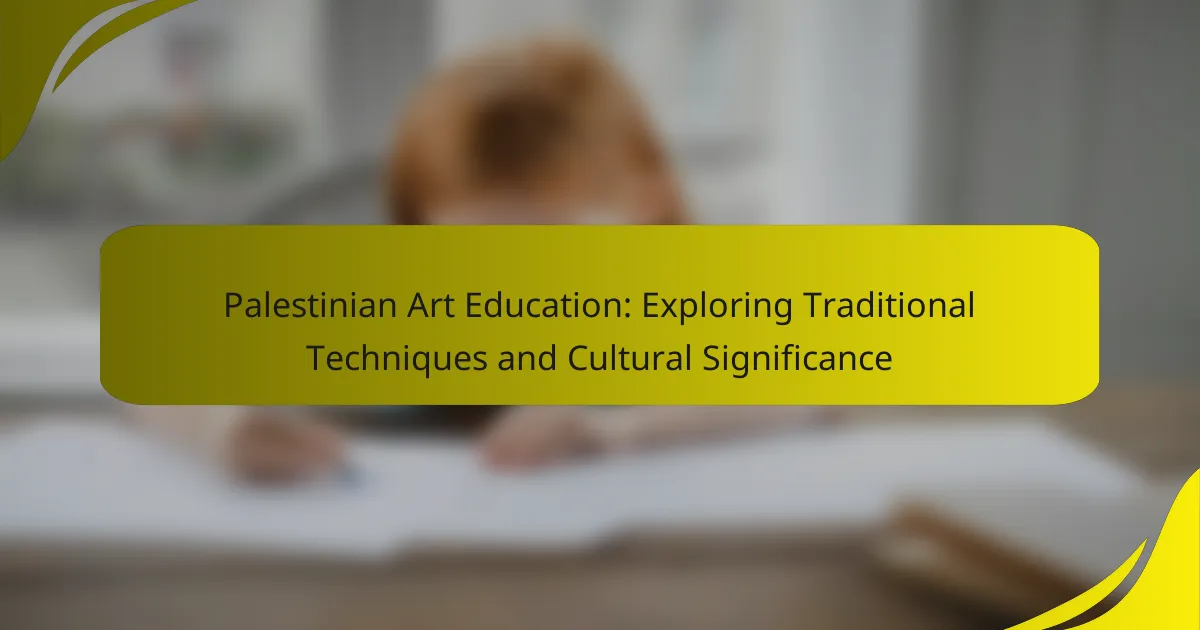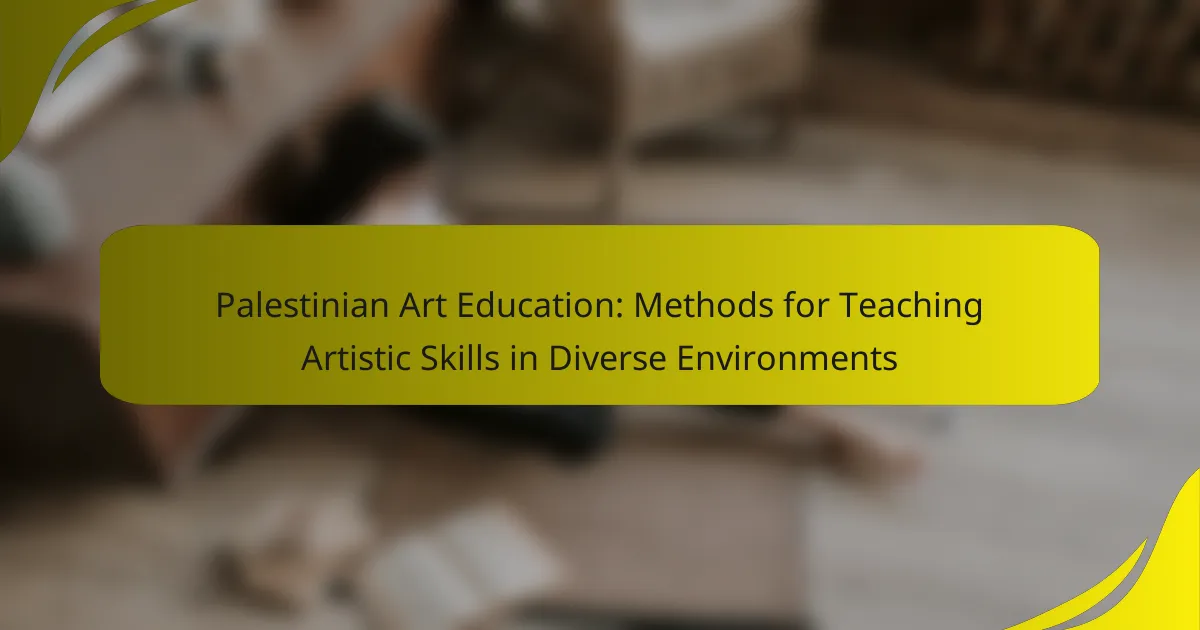Palestinian Art Education is a structured system designed to teach art within the Palestinian territories, emphasizing the development of artistic skills and cultural expression among students. This education integrates traditional Palestinian themes with contemporary techniques, aiming to nurture creativity and innovation in young artists. Various institutions and community programs offer art classes and workshops that highlight the significance of cultural identity and heritage while addressing social and political issues through creative means. Despite facing challenges such as limited resources, political instability, and economic hardships, the educational framework strives to empower youth and preserve cultural narratives by utilizing hands-on experimentation, collaborative projects, and mentorship from experienced artists.
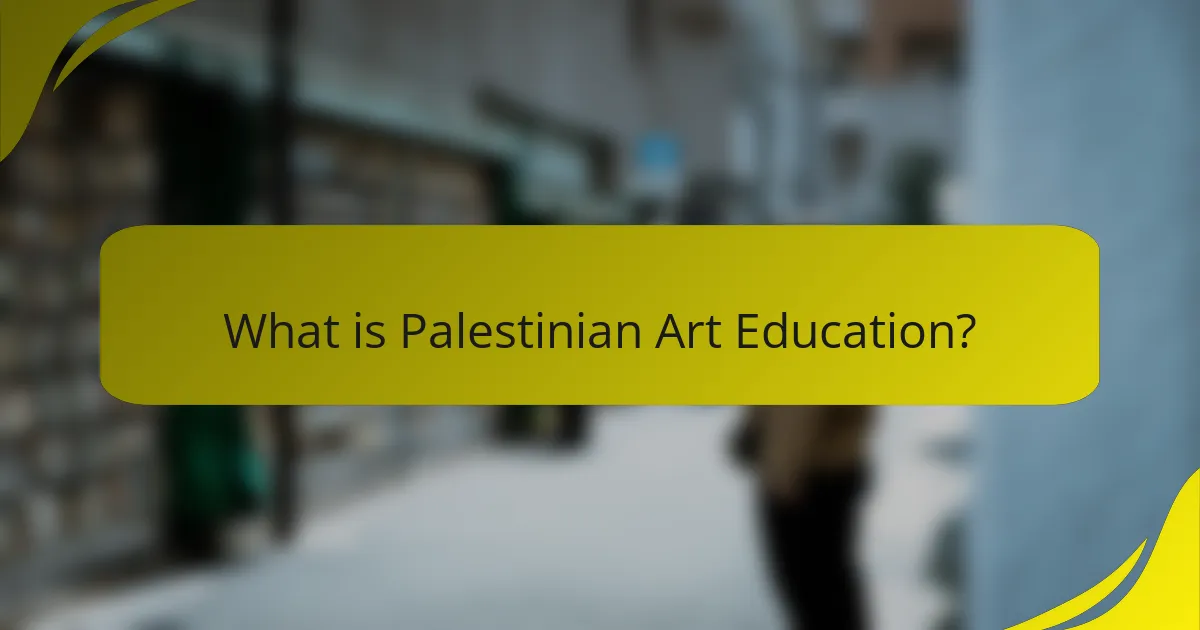
What is Palestinian Art Education?
Palestinian Art Education is a system of teaching art within the Palestinian territories. It focuses on developing artistic skills and cultural expression among students. This education incorporates traditional Palestinian themes and contemporary techniques. It aims to foster creativity and innovation in young artists. Various institutions and community programs offer art classes and workshops. These programs emphasize the importance of cultural identity and heritage. Art education in Palestine also addresses social and political issues through creative expression. Overall, it plays a crucial role in empowering the youth and preserving cultural narratives.
How does Palestinian Art Education differ from other art education systems?
Palestinian Art Education emphasizes cultural identity and social issues more than many other art education systems. It integrates local history and heritage into the curriculum. This approach fosters a sense of belonging and community among students. Palestinian art educators often focus on resistance themes and political expression. This reflects the unique socio-political context of Palestine. In contrast, other systems may prioritize technical skills or global art trends. The incorporation of traditional techniques alongside contemporary methods is also notable in Palestinian art education. This blend encourages innovation while respecting cultural roots.
What historical influences shape Palestinian Art Education?
Palestinian Art Education is shaped by historical influences such as cultural heritage, colonialism, and socio-political struggles. The rich cultural heritage includes traditional crafts and visual arts that reflect the identity of the Palestinian people. Colonialism, particularly during the British mandate and subsequent Israeli occupation, has impacted the themes and expressions in art education. Socio-political struggles, including displacement and resistance, have also informed artistic narratives. These influences create a unique framework for art education that emphasizes resilience and creativity. The integration of these historical elements is essential for understanding contemporary Palestinian artistic practices.
How do cultural factors impact the teaching of art in Palestine?
Cultural factors significantly impact the teaching of art in Palestine. The rich heritage and history of Palestinian culture influence artistic expression. Traditional themes often reflect social and political narratives. Art education incorporates local customs and folklore, enhancing relevance for students. Cultural identity plays a crucial role in shaping artistic perspectives. Furthermore, the socio-political context affects access to resources and materials. Teachers often adapt curricula to reflect cultural values and community needs. This integration fosters a sense of belonging and pride among young artists.
What are the core objectives of Palestinian Art Education?
The core objectives of Palestinian Art Education are to promote cultural identity and self-expression among students. This education aims to foster creativity and innovation in young artists. It encourages critical thinking and visual literacy. Palestinian Art Education also seeks to provide a platform for social and political commentary. It emphasizes the importance of heritage and history in artistic expression. Furthermore, it aims to develop technical skills in various art forms. This education encourages collaboration and community engagement through art projects. Lastly, it strives to empower students to use art as a tool for change and advocacy.
How does Palestinian Art Education aim to foster creativity?
Palestinian Art Education aims to foster creativity by integrating cultural heritage into artistic practices. This education emphasizes the importance of local narratives and traditions. Students are encouraged to express their identity through various art forms. Workshops and collaborative projects promote innovative thinking. Exposure to diverse artistic techniques enhances creative skills. Additionally, mentorship from established artists provides guidance and inspiration. Research indicates that culturally relevant education boosts student engagement and creativity. Programs focus on critical thinking and problem-solving through art-making.
What role does innovation play in Palestinian Art Education?
Innovation plays a crucial role in Palestinian Art Education by enhancing creative expression and cultural identity. It encourages students to explore new techniques and mediums. This approach fosters a dynamic learning environment. Innovative practices help students engage with contemporary issues. They also connect traditional art forms with modern interpretations. Research indicates that art education focused on innovation improves critical thinking skills. Programs integrating technology and collaborative projects show increased student engagement. Therefore, innovation is essential for developing the next generation of Palestinian artists.
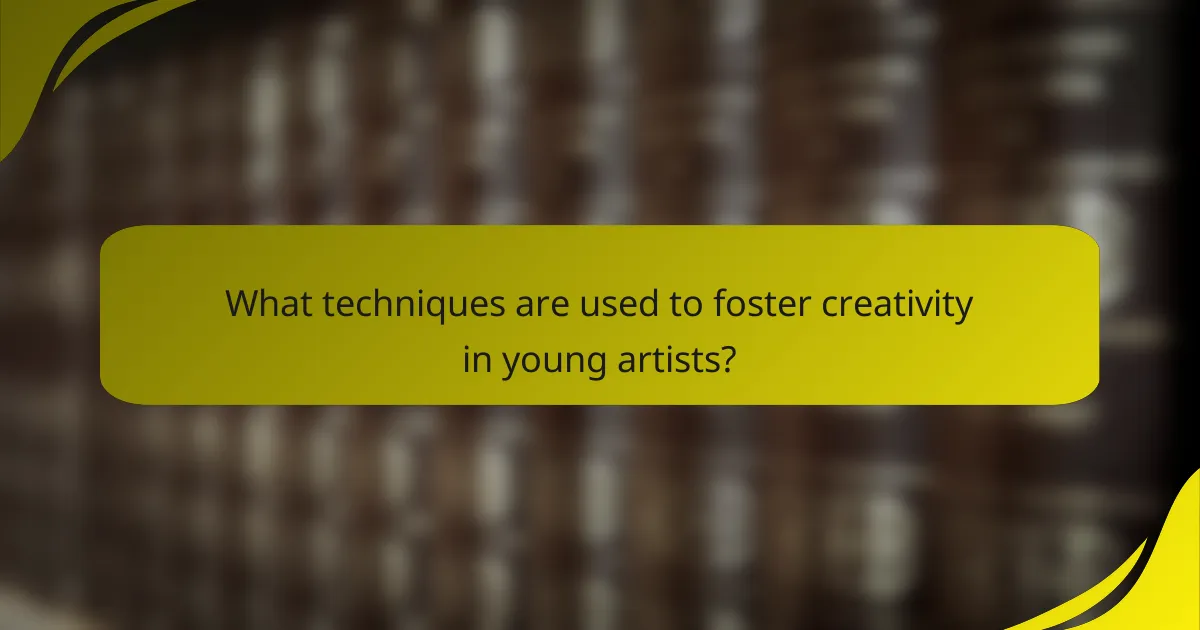
What techniques are used to foster creativity in young artists?
Techniques used to foster creativity in young artists include hands-on experimentation, collaborative projects, and exposure to diverse art forms. Hands-on experimentation allows artists to explore materials and techniques freely. Collaborative projects encourage teamwork and the sharing of ideas. Exposure to diverse art forms broadens artistic perspectives and inspires innovation. Additionally, mentorship from experienced artists provides guidance and encouragement. Workshops and art classes often incorporate these techniques to enhance creativity. Research indicates that such approaches significantly improve artistic skills and creative thinking in young individuals.
How do hands-on activities contribute to creativity in art education?
Hands-on activities significantly enhance creativity in art education. They allow students to engage directly with materials and techniques. This tactile experience fosters exploration and experimentation. Engaging in hands-on tasks helps students develop problem-solving skills. It encourages them to think outside the box and generate unique ideas. Research indicates that active participation boosts cognitive functions related to creativity. A study published in the Journal of Educational Psychology found that students involved in hands-on projects showed higher levels of creative thinking. Thus, hands-on activities are essential for nurturing creativity in art education.
What types of hands-on activities are most effective?
Effective hands-on activities in art education include collaborative projects, individual art creation, and interactive workshops. Collaborative projects encourage teamwork and idea sharing among young artists. Individual art creation allows for personal expression and skill development. Interactive workshops engage students in practical techniques and materials. Research indicates that these methods enhance creativity and innovation. A study by the National Art Education Association shows that hands-on activities significantly improve student engagement and learning outcomes in art education.
How can educators assess creativity through these activities?
Educators can assess creativity through activities by observing student engagement and originality in their work. They can evaluate how students approach problems and generate unique solutions. Assessment can include analyzing the use of materials and techniques. Educators may also implement peer reviews to gather diverse perspectives on creativity. Additionally, reflective journals can help students articulate their creative processes. Rubrics that focus on innovation and expression can provide structured feedback. Research shows that creative assessments improve student motivation and learning outcomes. For instance, a study by Craft (2005) highlights the importance of creative thinking in education.
What role does cultural heritage play in fostering creativity?
Cultural heritage significantly fosters creativity by providing a rich source of inspiration. It encompasses traditions, customs, and artistic expressions passed down through generations. These elements serve as a foundation for new ideas and artistic innovation. For example, Palestinian cultural heritage includes unique motifs, stories, and techniques that can be reinterpreted by contemporary artists. Studies show that engaging with cultural heritage enhances creative thinking and problem-solving skills. Research indicates that artists who draw from their cultural backgrounds often produce work that resonates deeply with audiences. This connection can lead to a more profound exploration of identity and community in art.
How can traditional Palestinian art forms inspire young artists?
Traditional Palestinian art forms can inspire young artists by showcasing cultural heritage and identity. These art forms include embroidery, pottery, and calligraphy. Each medium carries historical significance and tells stories of resilience. Young artists can learn techniques that emphasize craftsmanship and creativity. Exposure to these traditions promotes appreciation for cultural diversity. Engaging with traditional forms encourages innovation through personal interpretation. Workshops and community projects can facilitate this connection. Research shows that cultural engagement enhances artistic expression and creativity in youth.
What methods can educators use to integrate cultural heritage into lessons?
Educators can integrate cultural heritage into lessons through various methods. One effective method is incorporating local art forms into the curriculum. This can include teaching traditional Palestinian crafts, such as embroidery or pottery. Another method is utilizing storytelling to convey cultural narratives and historical contexts. Engaging students in discussions about cultural symbols and their meanings can also enhance understanding. Field trips to local museums or cultural sites provide experiential learning opportunities. Collaborative projects with community artists can foster connections between students and their heritage. Additionally, using multimedia resources, such as documentaries or music, can enrich lessons with cultural context. These methods not only educate but also instill pride in cultural identity.
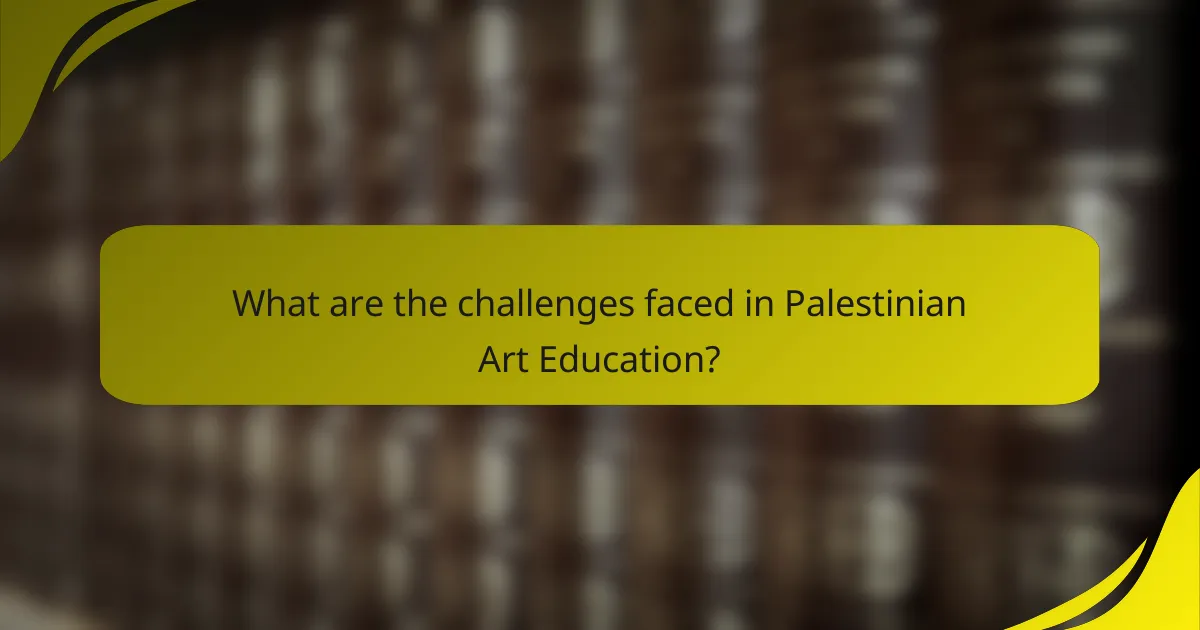
What are the challenges faced in Palestinian Art Education?
Palestinian art education faces significant challenges. Limited resources hinder access to materials and facilities. Political instability disrupts educational continuity. Restrictions on movement affect students and teachers. Cultural censorship limits creative expression. Economic hardships reduce funding for art programs. Lack of trained educators impacts the quality of instruction. These factors collectively undermine the development of artistic skills in Palestinian youth.
How do socio-political factors affect art education in Palestine?
Socio-political factors significantly affect art education in Palestine. The ongoing conflict and occupation create instability in educational infrastructure. Limited resources hinder access to quality art materials and trained instructors. Political restrictions also affect curriculum development and freedom of expression in art. Additionally, socio-economic challenges impact students’ ability to participate in art programs. Cultural identity and resistance are often expressed through art, influencing its teaching methods. The lack of funding for art initiatives restricts opportunities for young artists. Overall, these factors shape the landscape of art education in Palestine.
What specific challenges do young artists face in this environment?
Young artists in Palestine face significant challenges in their environment. Limited access to resources hinders their ability to create and showcase art. Political instability affects their freedom of expression and opportunities for collaboration. Economic constraints restrict funding for art projects and education. Cultural restrictions may limit the themes and subjects they can explore in their work. Additionally, lack of mentorship and professional networks can isolate young artists from the broader art community. These challenges collectively impact their artistic development and career prospects.
How can educators address these challenges effectively?
Educators can address challenges in Palestinian art education by incorporating culturally relevant techniques. Emphasizing local history and identity fosters a sense of belonging. Utilizing community resources enhances engagement and support for students. Collaborative projects encourage peer learning and creativity. Providing access to diverse art materials stimulates innovation. Continuous professional development equips educators with effective teaching strategies. Research indicates that culturally responsive teaching improves student outcomes ([censured], 2010). These approaches create a supportive environment for young artists to thrive.
What resources are available to support Palestinian Art Education?
Resources available to support Palestinian Art Education include various organizations and initiatives. The Al-Quds University Art Department provides academic programs focused on art education. The Palestinian Museum offers workshops and exhibitions promoting local artists. The Qattan Foundation supports arts and culture through grants and educational programs. Additionally, international collaborations with organizations like UNESCO enhance art education resources. These resources aim to foster creativity and innovation among young Palestinian artists.
How can community organizations contribute to art education?
Community organizations can enhance art education by providing resources, workshops, and mentorship. They often offer funding for art programs in schools. This financial support can help purchase supplies and hire qualified instructors. Additionally, organizations can host community art events that engage students and families. These events promote collaboration and creativity among participants. Furthermore, mentorship programs can connect students with local artists. This relationship can inspire young artists and provide them with guidance. Research shows that community involvement in education improves student outcomes. Involving community organizations in art education fosters a supportive environment for young artists.
What role do online platforms play in enhancing art education access?
Online platforms significantly enhance access to art education. They provide a wide array of resources such as tutorials, workshops, and courses. These platforms enable learners to access content from anywhere, breaking geographical barriers. Many online platforms offer free or low-cost resources, making art education more affordable. According to a report by the National Endowment for the Arts, online learning has increased participation in arts education. Furthermore, social media allows artists to share their work and gain feedback, fostering a collaborative learning environment. This accessibility supports diverse learning styles and paces, accommodating various needs. Overall, online platforms democratize art education, making it more inclusive and widespread.
What best practices can enhance Palestinian Art Education?
Incorporating community engagement can enhance Palestinian Art Education. Engaging local artists in workshops fosters a connection between students and their cultural heritage. Integrating traditional Palestinian art forms into the curriculum strengthens identity and creativity. Providing access to diverse art materials encourages experimentation and innovation. Implementing collaborative projects promotes teamwork and communication skills among students. Regularly showcasing student artwork in community spaces builds confidence and public recognition. Establishing partnerships with art institutions can provide resources and mentorship opportunities. These practices collectively enrich the educational experience and nurture young artists.
How can educators create an inclusive environment for all young artists?
Educators can create an inclusive environment for all young artists by implementing diverse teaching strategies. These strategies should accommodate different learning styles and cultural backgrounds. Incorporating various art forms can engage students from different communities. Providing materials that reflect diverse cultures promotes representation. Encouraging collaboration among students fosters a sense of belonging. Creating a safe space for expression allows students to share their unique perspectives. Regularly seeking feedback from students can help educators adjust their approaches. Research shows that inclusive classrooms improve overall student engagement and creativity.
Palestinian Art Education is a system designed to cultivate artistic skills and cultural expression among students in the Palestinian territories. This education uniquely emphasizes cultural identity, social issues, and the integration of traditional and contemporary techniques, reflecting the socio-political context of Palestine. Key objectives include fostering creativity, critical thinking, and self-expression while addressing challenges such as limited resources and political instability. The article explores methods to enhance creativity through hands-on activities, the role of cultural heritage, and the impact of community organizations and online platforms in supporting art education.
